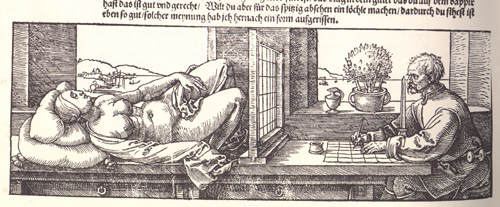
Art Home | ARTH Courses | ARTH 200 Assignments
Comparison between East and West
In class the other day we discussed this image by Albrecht Dürer of an artist drawing a nude. As I said in the discussion, I think this image is much more than an illustration of a device to enable the artist to render perspective. This work can be seen to represent the dominant attitude (or paradigm) of how western culture has looked at the world. The emphasis on the rational artist rendering the nude and the world through the perspective device is a paradigm in western thought. It is the same paradigm as how the scientist looks at and measures the world. The imposition of a grid onto the world is much like the ordering of cartography into longitudes and latitudes. The emphasis on clear boundaries evident in the illustration echoes the boundaries that order our experience whether it be the organization of a college faculty into departments and specializations, or boundaries or borders that mark divisions in private property or nation states. The Google Earth shot of Iowa dramatically illustrates the human imposition of rational boundaries onto the natural world.
This paradigm is so dominant in western culture, it is hard for us to imagine looking at the world in a different way. It has become for us the "natural" way of looking at the world and dividing our experience. Remember that just as we divide space into measurable units, our experience of time has the comparable imposition of a rational measuring system imposed on it. I have included on the web page entitled The Power of Perspective some statements by scholars discussing the implications of the invention of perspective for western culture.
One of the values of the discipline of Art History is that it gives us the opportunity of looking at the world in a different way. The habit of mind that that is the paradigm for western culture is not universal, and that other cultures looked at the world in dramatically different ways. As a way of demonstrating this, I would like us to do a comparison between western landscape painting and Chinese landscape painting. To exemplify the western tradition I want to use a painting by the French seventeenth century painter Nicholas Poussin entitled Landscape with the Funeral of Phocion (1638):
Compare Poussin's treatment of the landscape to the Dürer illustration. The following illustration presents an analysis of the linear perspective system of the Poussin painting. The red lines are the orthogonals that intersect at the vanishing point while the blue line is the horizon line of the painting which articulates the eye-level of the defined viewer of the painting. The vanishing point of the Poussin painting is equivalent to the tip of the gnomon which defines the point of view used by the artist drawing the nude in the Dürer illustration. Look at how everything makes sense in the Poussin painting from this point of view.
Consider also how you can apply the binary table we have devised to the Poussin painting. In your journal record your responses. Later in the seventeenth century saw the construction of the French royal palace at Versailles here illustrated in a roughly contemporary painting:
This presents perhaps the ultimate sovereign gaze in western culture. Where do you think the bed chamber of King Louis the XIV was located in the palace?
To exemplify the Chinese tradition I want to consider a scroll entitled Summer Mountains done by an eleventh century painter by the name of Qu Ding:
attributed to Qu Ding (active c. 1023-c. 1056), Summer Mountains. (17 7/8" X 45 3/8") (300 dpi image) |
|
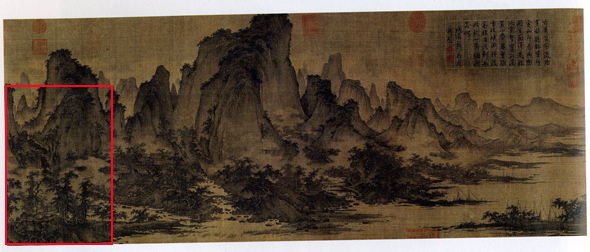 |
|
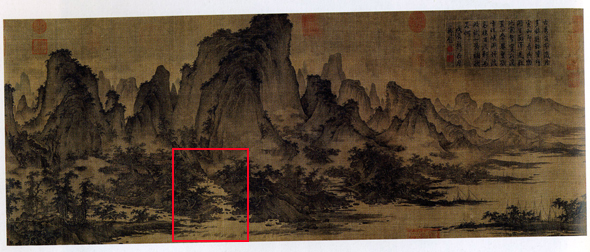 |
|
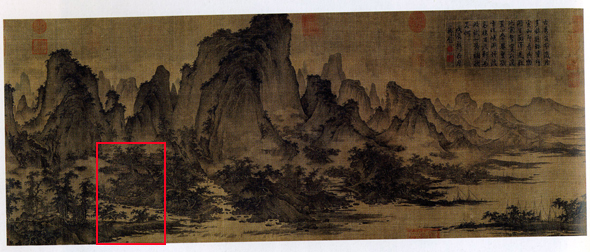 |
|
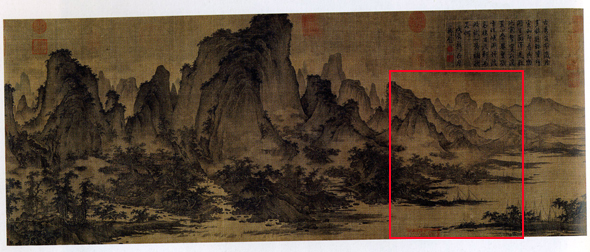 |
|
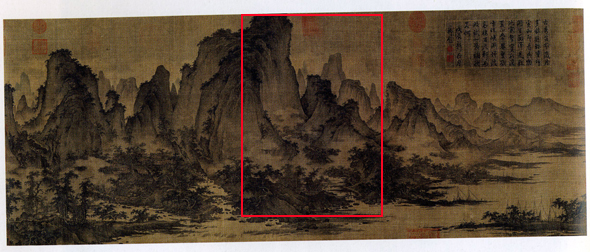 |
|
Try to apply the paradigm evident in the Dürer illustration to this Chinese landscape, and also try to relate this painting to the binary table [in your journal record your responses] . A crucial issue to consider is the question of the point of view. As we have seen in other examples of western painting we have looked at, the Poussin, like the Dürer illustration, imagines us as looking through a window at what is represented beyond. The Chinese artist imagines the viewer as wandering through the landscape. Don't rush looking at this painting; through the details, spend some time "wandering" through this landscape. Consider the dramatically different relationship this establishes between the viewer and nature. Remember that this is not just an artistic idea, but reflects fundamentally different attitudes towards the formulation of "man" and "nature."
I would hope you would consider the implications or consequences of understanding the world through these different paradigms. Write your responses in your journal.
[other examples of Chinese paintings]
Introduction to taoism.
It is important to draw a distinction between the binary table and the concept of yin and yang in Asian philosophy. The binary table we have constructed are opposing forces with one side dominating over the other. While in Asian philosophy the yin and yang or opposites are in a complementary relationship to each other. They are interdependent with one not dominant over the other. One cannot exist without the other.
Steinberg